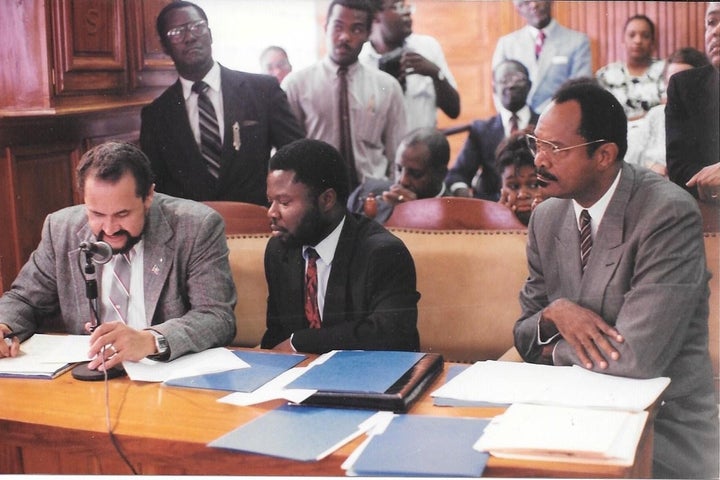It looks as if China is willing to make good on its agreement with Haiti for the renovation of Port-au-Prince. In a letter to Xie Yong Jian, an Advisor to China’s Southwest Municipal Engineering Design and Research Institute, Port-au-Prince Mayor Ralph Youri Chevy agreed to accept the Port-au-Prince Municipal Renovation Project. The project contains proposals for water and drainage works, road improvements, environmental protections, drainage and sanitation, a communications network and reconstruction of the old city of Port-au-Prince. The initial infrastructure investment is $4.711 billion. You can read the letter here.
“After thorough research and prudent consideration, the municipal government hereby supports the implementation of the Port-au-Prince Municipal Renovation Project by leveraging international investment and finance.”
It is unclear at this point where the money will come from, but China is definitely moving forward. The day before the signing, a hard-hitting video surfaced on YouTube, in French and English, outlining the project in extensive detail.
If this project comes to fruition, it is sorely needed in a country that has seen massive infusions of foreign aid since the 2010 earthquake and very little benefits. See this analysis. My last visit was in December 2015 and not much had changed.
The promised infrastructure seems almost too good to be true, but let’s hope that dreams can indeed come true for the Haitian people. China has made good on similar projects in its estimated Trillion dollar “Silk Road” initiative, not to mention 30 futuristic infrastructure projects in its own country. Perhaps the future has finally arrived for Haiti, and as a result the Caribbean corridor will be transformed.

Screen shot from Chinese video
100 km (62 miles) of 12 main roads will be completely re-engineered. This does not sound like much unless you have ever tried to drive in the Port-au-Prince municipality. Drainage engineering will take center stage with flood interception trenches and rainwater runoff collection systems that will be routed to the rivers and the sea.
After the United Nations Nepalese contingent contaminated all of the central waterways with cholera in October of 2010, a water purification plant capable of handling 225,000 cubic meters per day (59438711.8 US liquid gallons) will be a godsend. Distribution plans have not yet been made public.
A new sewage plant will treat 18,0000 cubic meters per day ”to required standards and be discharged along the rivers and sea,” according to project engineers quoted in the video.
Public toilets (450) and garbage collection will transform the cityscape and the “timely disposal of garbage during the day is expected.”
Waste landfills will accept 1,500 tons per day for domestic waste.
A new gas fired power station has a planned 2000 mega watt output. In India, 1 MW will power 1500 homes; in the United States a mere 145 homes. Of course power usage will determine how far 2000 MW can go. Solar is not mentioned as an option, but at this point a reliable source of power is welcome in Port-au-Prince. Imagine no more rolling blackouts everyday. You can find a primer on energy terms here, with some interesting comparisons.
A new communications proposal promises to provide reliable cell service and a nexus linking a central Internet Data Center with road monitoring and emergency dispatch systems.
Founded in 2008, Bati Ayiti S.A. is a Haitian corporation that is the engine behind this initiative. It was founded in 2008 by Amos Andre, Hans Tippenhauer and William Zreik. The Bati Ayiti Group has three Subsidiaries: Bati Ayiti Aggregates, Bati Ayiti Consulting, and Ville du Lac Development.
Amos André is a former politician and the founder of the political party, Font Uni. He was elected Senator of the Republic for the Department of the Northeast for two years in December 1990. André was re-elected at the end of the term with a majority of 79% of the votes cast for a term of six years in the 45th Legislature.
In late July and early August of this year The Haitian Press Agency (AHP) reported that China would invest $30 billion. Bati Ayiti and its Chinese partners signed an agreement for the renovation of Port-au-Prince with the Municipality of Port-au-Prince.

Senators Bernard Sansaricq, Amos Andre, and Thomas Eddie Dupiton (left to right) (circa 1990)
Bernard Sansaricq, who served with André in the Senate said in an email, “ I think the 4 Billion US is only to rebuild Port-au-Prince, and the 30 billion for project around the country. Again, knowing Haiti, the Chinese might be taking it slowly, not to get hurt.”
No stranger to the forces of corruption, Sansaricq cautions, “If we can control the greediness of those people in power, (then) the project will really benefit the Nation and the poor masses of the country.”
André was unavailable for a comment.
Indeed it would be wise for China to takes things slowly. According to the Haiti Sentinel, there are dark forces trying to control development projects. “In Haiti, a trio of wealthy businessmen involved in the electricity sector and characterized as the ‘energy Mafioso,’ have successfully, according to reporting, forced, possibly through extortion, President Jovenel Moise to withdraw from a $2 billion [USD] plan with China to electrify all of Haiti.”
China needs to tread carefully through the cesspool of corruption. Let’s also hope that the project will eventually extend beyond Port-au-Prince.
